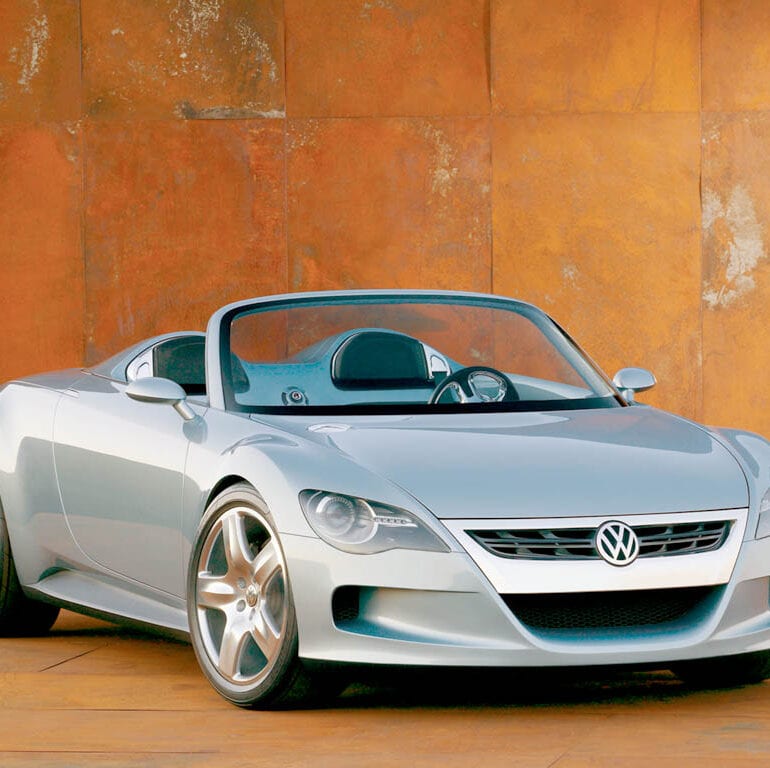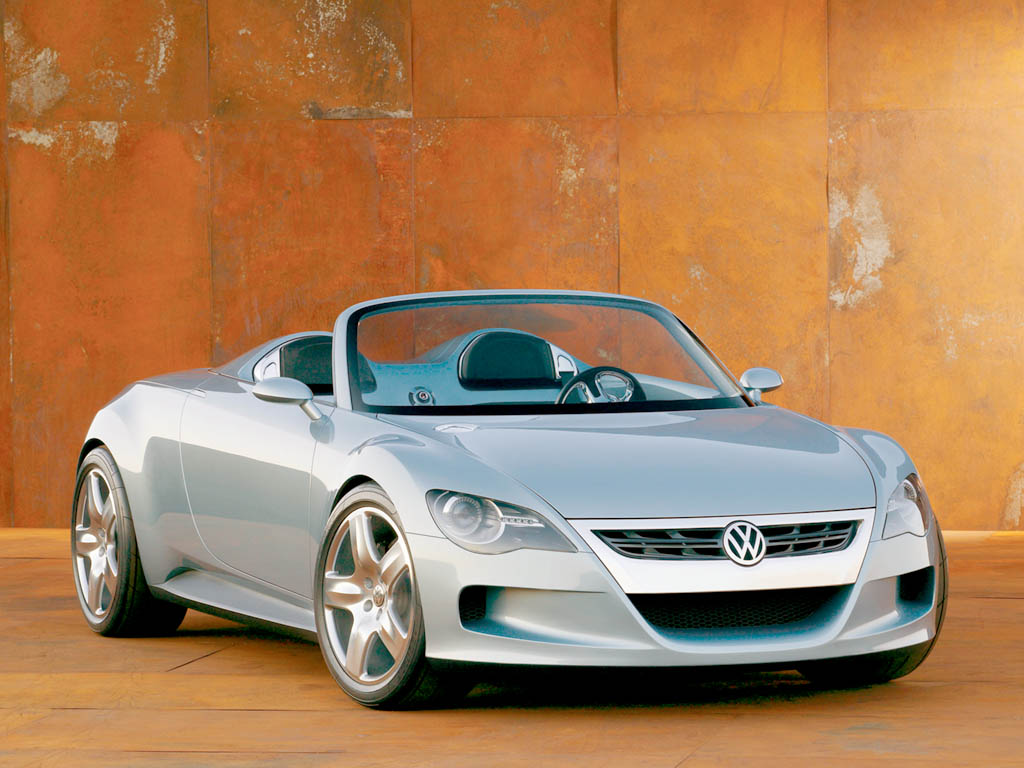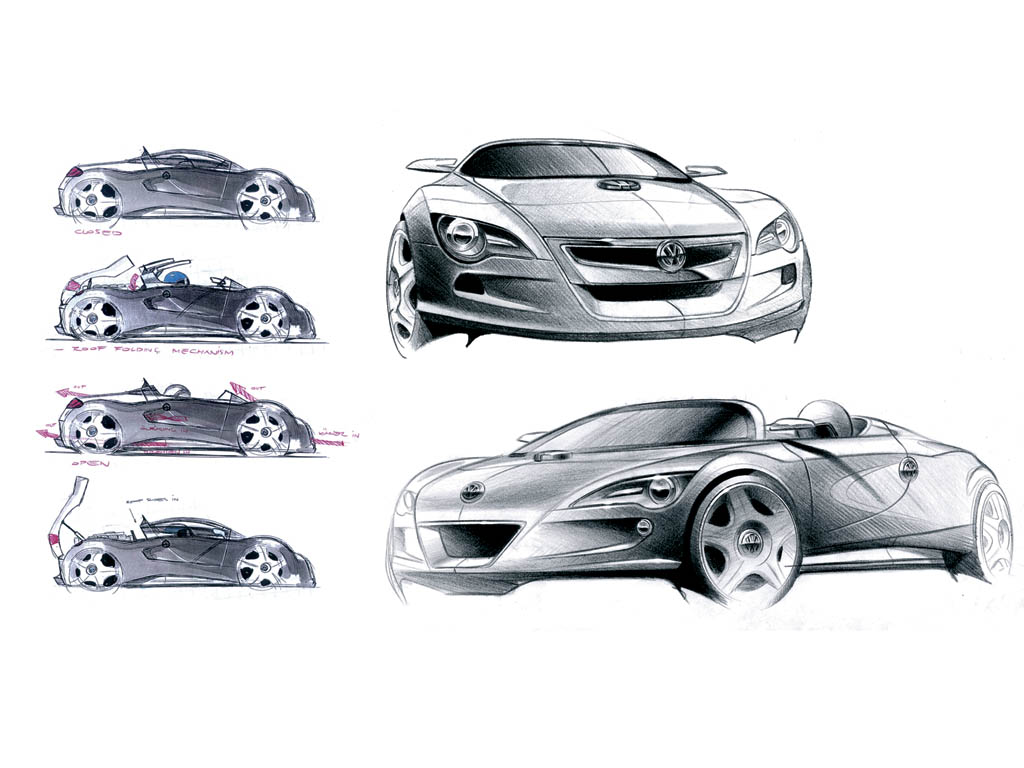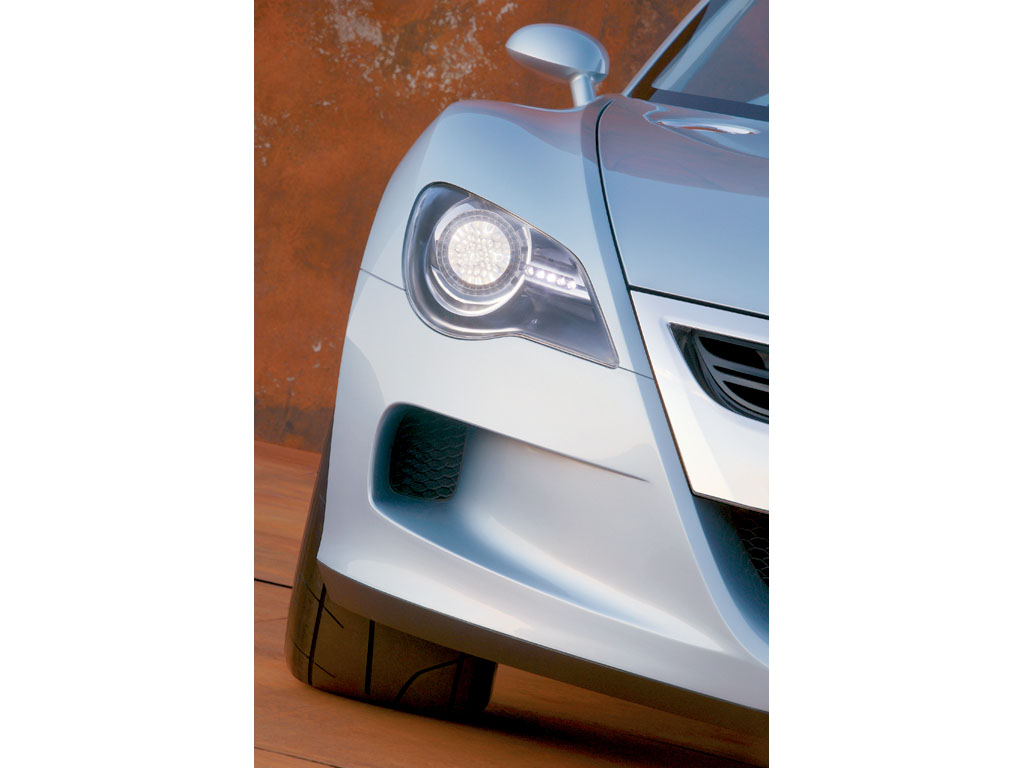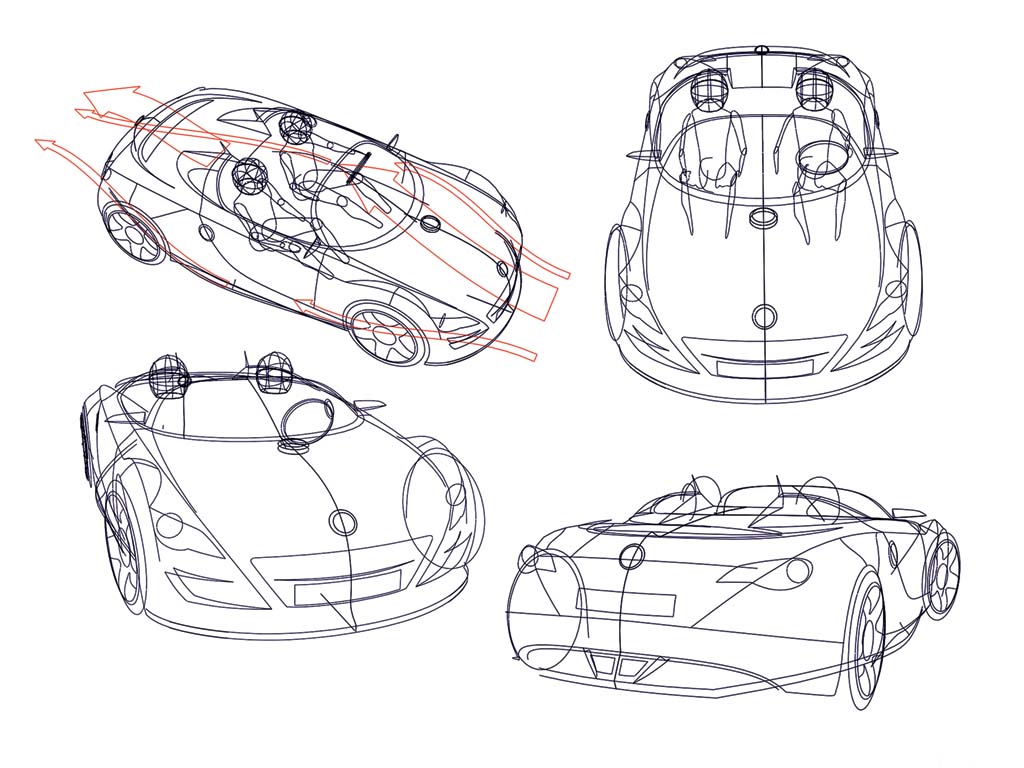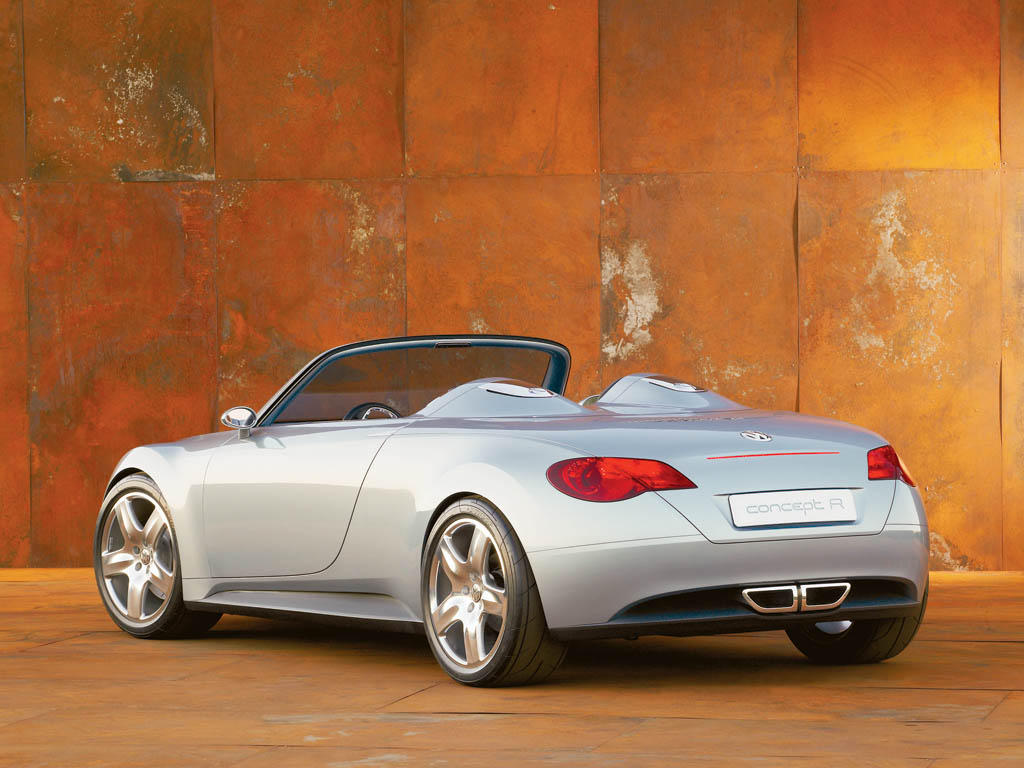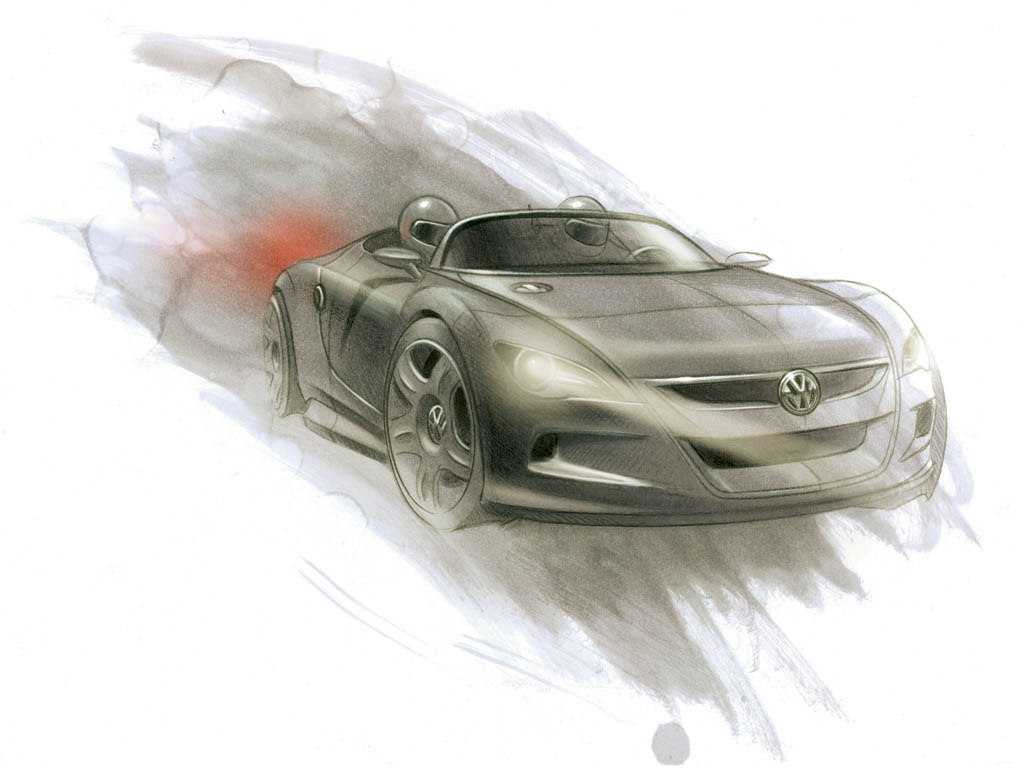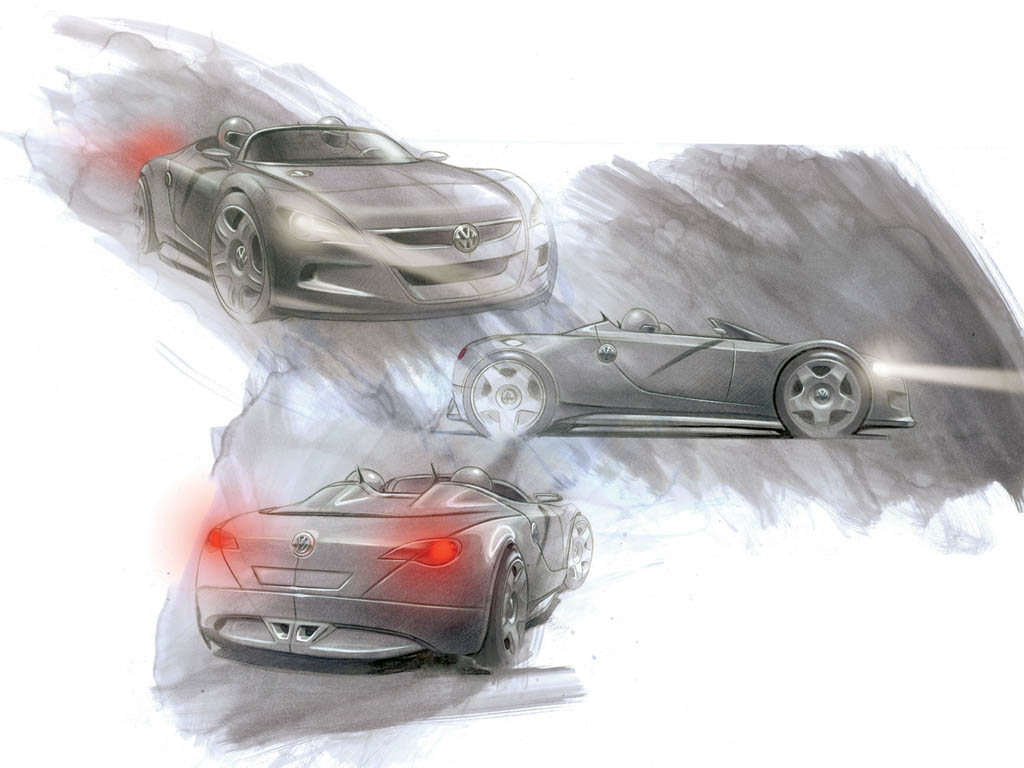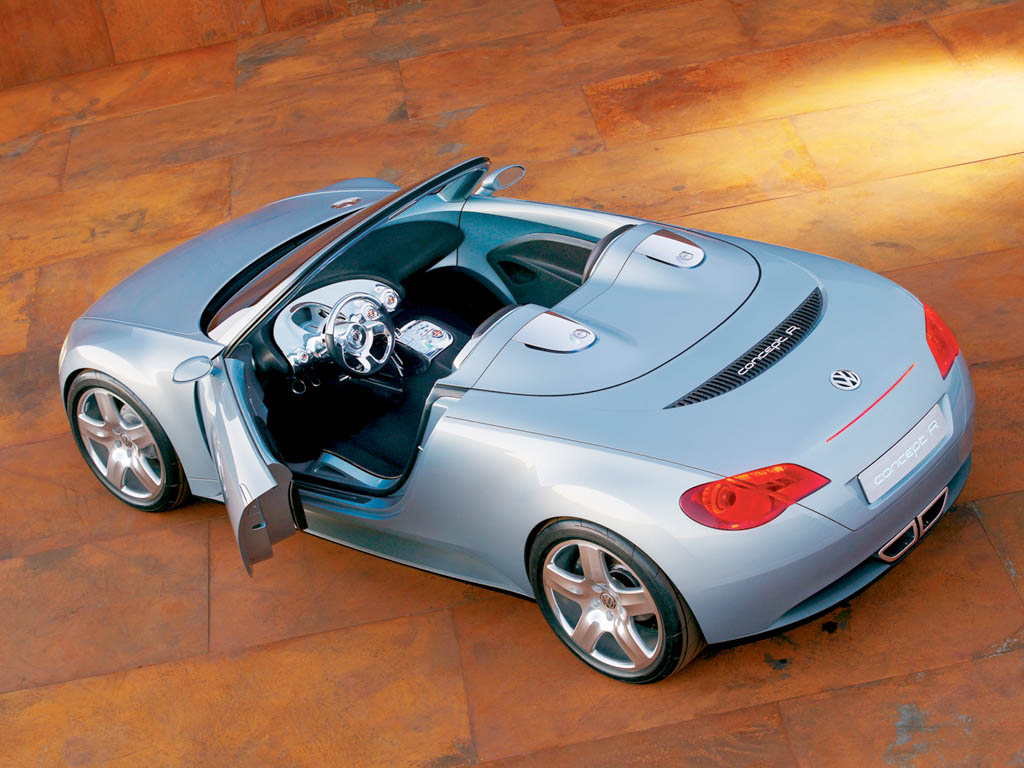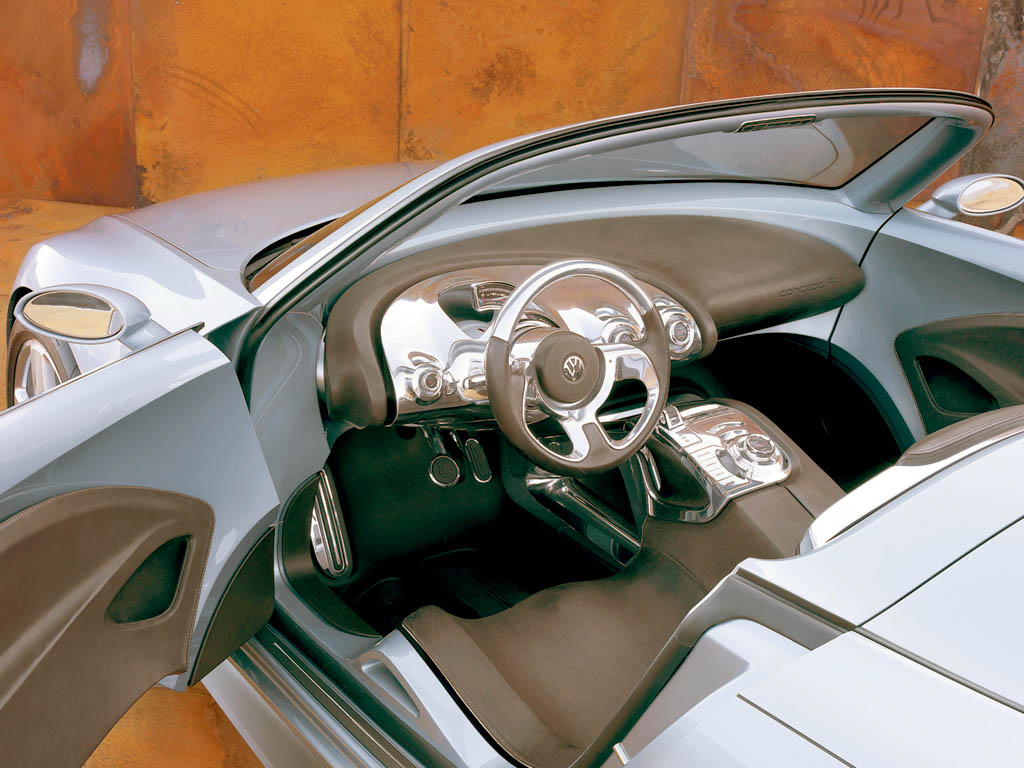2003 Volkswagen Concept R
Wolfsburg. Just seven days after the world premiere of the new Golf, Volkswagen presents a further facet of automobile fascination: The roadster prototype concept R. The great sharpness in design, seen from every angle, combined with outstanding functional solutions indicates what the Brand has in store for the future and also a possible involvement in the world of real and genuine sports cars.
Propulsion for the concept R comes from a V6 mid-engine; It returns 195 kW / 265 brake horse power and accelerates the roadster in 5.3 seconds to 100 km/h. If the propelling power was not governed to 250 km/h, in theory, the top speed would be 270 km/h. The engine torque (350 Newton metres at 2,800 rpm) is transferred to the road via a spectacular Volkswagen direct selection gearbox (DSG / 6-speed) and rear axle.
Chosen consciously to provide a contrast, the designers applied colour to the exterior and interior: Frozen sky paint finish, dark earth interior leather.
Design Concept
The design team, led by Murat Gunak (Volkswagen Brand Group) and Peter Schreyer (Volkswagen Brand), shows with the roadster concept R how a sports car packed with aesthetics and emotion could look in the foreseeable future with the internationally successful VW label. The 4.16 metre long, 1.78 metre wide and just 1.25 metre high two-seater has a convincingly powerful body and an interior that conquers virgin territory in terms of style in every detail.
The basis for the highly dynamic exterior design forms a very clear linear structure, which distinguishes all of today’s Volkswagens. But these lines are set sharper than ever and, with a new appearance, frame extremely exciting and well formed surfaces. This new three dimensionality in the important body elements forms, with the virtuosity of a concept bearing the slogan ‘anything is possible’, a path to tomorrow’s foreseeable world. The concept R continues where the Phaeton, Touareg, New Beetle Cabriolet and Golf make their mark to further enhance dynamics and emotion with crystal clear structures and functional levels by placing itself ahead without compromise as a forerunner of Volkswagen design.
Front End
particularly avante garde element of the concept R is seen in the front end with its newly designed Volkswagen radiator grille and large V-shaped air cooling inlet below. The chrome badge, integrating the VW logo in the centre, is where air is drawn in for the V6 engine to breath and the new look of the eye-like headlights creates a face that can immediately be associated with the Volkswagen Brand tradition, even though a complete reinterpretation of the design has been possible. The designers were conscious in their efforts to instil in the front end of this sports car the agility and vigilance of an animal about to jump.
The bonnet of the front luggage compartment (mid-engine!) continues the V of the radiator grille extension and contours it upwards to the A pillars. This V is stressed by two flowing protrusions that separate the wings and bonnet contour on the left and right. The wings are designed more as independent and powerful structures and on both sides feature a further inlet for cooling of the front brakes.
LED headlights with lenses
Absolutely dominant: Headlights integrated in the wings with outer, round main element and an inner part narrowing to a point towards the centre of the vehicle. Inline with the Phaeton, Touareg and new Golf, the wing area is extended prominently to the front above the headlights like an eyebrow and underlines in this way the athletic character of the concept vehicle.
True to this image is a technical novelty in the form of headlights with ultramodern LED technology: As soon as they are switched on, a lens begins to open on each side. Before the aperture widens, all that can be seen is a narrow beam of light and then the full lighting power becomes available for dipped or main beam. The optical effect of this focussing of the vehicle eyes makes the concept R appear to come alive, inline with the whole characteristic design.
The way future and past can be combined in a fascinating way is shown in the front end with a stylistic homage to the world of sports cars of the 50s: The tank filler neck on the left of the bonnet is finished as an independent style element.
Silhouette
The flank of the concept R is distinguished by: a very flat waistline, rising to the centre of the rear wheelarches; naturally round, heavily contoured wheelarches; and a very short rear overhang. The new design is also continued here with its own fascination in form and function. And again the term three dimensionality comes to light. Inline with the New Beetle, there are just three prominent lines that form the silhouette of the concept R: Two semi-circles each for the high rise of the wheelarches and one straight line closing to a semi-circle at the rear of the waistline.
Furthermore, the three dimensionality of the design is emphasised par excellence in the side rear end area: The surface of the wings above the prominent semi-circles of the wheelarches is drawn into the rear end and is visible only from the rear to form an extremely powerful and independent unit. Similar to the new Golf, the tail lights have a transparent finish, even when seen from the side, and form an important style element thanks to their crystal clear appearance
Nothing disturbs the dynamics of the sides; Even the door handles, featuring keyless access, take on a subordinate role in the design
To ensure the homogenous silhouette of the concept R is not interrupted unnecessarily, the doors are integrated beautifully and unobtrusively into the design. To support this, the outer door handles are manufactured from a narrow but solid thin aluminium strip. Thanks to the keyless access system integrated here, all that is needed to lock and unlock the door is light contact with the handle as it ejects.
Rear End
Typical for Volkswagen: Even the powerfully created rear end features an absolutely unmistakable design. Inline with the front end, the boot forms a V, enhanced by an incomparable dynamic edge. The tail lights correspond in their form with the headlights. When activated, the light is built up in three stages as three LED blocks light up in succession. The tail lights have a round, lens-like outer main element to mark the style. In addition, the second, trapeze shaped part of the tail lights is integrated in the rounded wing edges, reminiscent of the rear of a muscle-packed animal.
Between the tail lights there is a very thin strip of diodes for the third brake light. The designers worked the VW logo into the space above this in the centre. Not until the roadster is seen up close is it possible to see the chrome concept-R lettering on the engine/soft top cover (mid-engine, fully retracting cover) as part of an outlet on the V6 engine. The chrome twin tail pipe of the exhaust system, finished again in the shape of a V, is a stylistic feature of the exhaling six cylinder. At each side of this there are two additional large air outlets that are designed like a diffuser.
The dynamic and emotional air of the concept R is underlined by two body domes behind the driver and front passenger in the style of a classic racing car. Not only are they powerful and elegant in their flowing lines, but they also fulfil two very practical roles: Wind deflection and over-roll protection. Integrated in the top of the driver’s dome is the chrome GPS aerial and in the front passenger’s dome is the GSM aerial.
Interior
Take one look at the interior of the concept R and view groundbreaking and fascinating form and function in harmony. The interior designers and design engineers developed an interior that has the layout, operating and information spectrum of a time tunnel that paves the way to the future. All information and operating elements are integrated in a new harmony of form and function.
A so-called OLED screen (flexible in shape and form with extremely high lighting power) breathes even more life into the concept R. And in a way that is as unusual as it is unexpected. The typical VW emblem in the steering wheel is no longer a tangible reality; It can now be found stored in the round display. As soon as the driver switches on the ignition, that is, when the concept R is switched to stand-by, the VW emblem begins to pulsate. When the ignition is activated, the pulse stops. Even though the VW logo is generated digitally by a display, it has a tangible appearance as if it were made of chromed metal.
Concepts have the power to blow rules to the wind: Why adjust the seats when the cockpit is flexible?
A completely new feature was introduced by the engineers in the way of ergonomics: The two bucket seats of the concept R are no longer adjustable. In fact, there is no way of adjusting them at all. Instead of the seat, the driver moves the polished aluminium operating and information block of the instrument panel, including steering wheel and pedal cluster, back or forth. The adjusting mechanism is activated electrically.
At the press of a button, the front passenger can also find an optimal seating position by moving a highly polished support element back or forth in the footwell. And this position is truly comfortable: The concept R fits perfectly and offers the highest level of seating comfort on long journeys, such as the winding roads of the Nurburgring-Nordschleife – exactly the reason why the concept of selecting the optimal seating position was reversed.
Thanks to a sophisticated and newly developed carrier mechanism, the seats are self-sprung; The hardness of the springs can also be adjusted. The seating comfort is enhanced even further by active foam used in the seat structure, which is covered in deer leather. Developed for space travel and adapted for extremely good office furniture with a price tag to match, this foam is being used in a sports car for the first time. It adapts perfectly like a modulated counter-structure to the individual contours of each body and thereby contributes towards an unusually high level of comfort and provides good ergonomic properties.
Another seat feature is one that promotes safety: When the driver and co-driver enter the vehicle, the head restraints are moved forwards automatically by five centimetres and thereby adopt an optimal position in terms of safety.
An optical and technical highlight of the concept vehicle is the instrument panel and centre console. All areas of the operating elements and displays, and also parts of the three-spoke steering wheel (self-climatised), are finished in polished aluminium. As a contrast, the dash cross member is covered in dark deer leather to avoid reflections from the windscreen.
The sports car cockpit captivates its audience by clarity, aesthetics and functional logic. Example: The air vents in the centre console, designed with a turbine appearance, display the selected temperature digitally and can be turned like a dial to set a new value. The combination of display and operation is as simple as it is remarkable. The hand is reached out intuitively to a point where the driver expects the function to be and where the temperature change can be felt directly.
A further novelty are the instruments themselves. The hardware provides digital information here too (with, in places, analogue characters), and here, as the project develops, ultramodern OLED screens will also be featured. Right at the heart of development work was again the need to interpret the harmony of form and function in a fascinating and new way. Example, main instrument or rather main function level: When the ignition is activated (no key required, just simply tap the START switch lightly), it opens up into the centre of the cockpit from the right. In this central display are the classic functions, such as speed or engine temperature.


